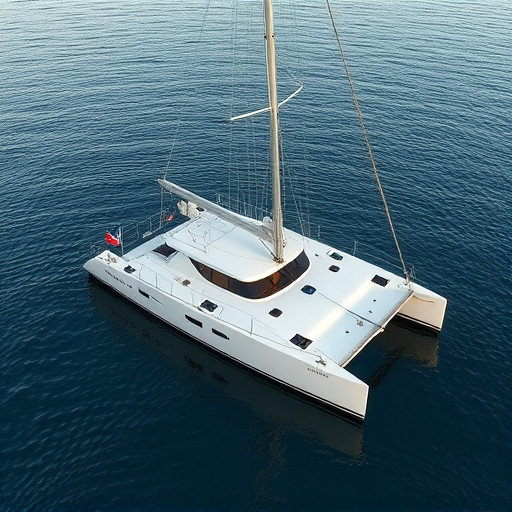Regular monthly inspections and proactive maintenance are vital for keeping your catamaran in peak sailing condition. Check hull integrity, rigging, sails, navigation equipment, and engine systems, including oil levels, filters, belt tensions, bilge systems, and water tanks. Examine the hull and deck for damage, corrosion, and rot, paying close attention to high-stress areas. This routine care extends the life of your catamaran, ensuring safe and enjoyable sailing adventures.
Navigating the open seas in a catamaran requires both skill and maintenance expertise. This guide offers essential tips for catamaran owners, ensuring smooth sailing experiences. From regular checks on critical components like the hull, engine, rigging, and electrical systems, to mastering maneuvers and adapting to weather conditions, each section delves into crucial aspects of maintaining and operating your catamaran effectively. Discover expert advice tailored to keep your vessel in peak condition, enhancing both safety and enjoyment during every voyage.
Regular Maintenance Checks

Regular maintenance checks are essential for keeping your catamaran in top condition, ensuring safe and enjoyable sailing experiences. A thorough inspection should be conducted at least once a month, covering all critical systems and components. This includes checking the hull for any signs of damage or corrosion, inspecting the rigging and sails for wear and tear, and verifying the functionality of navigation equipment such as GPS, radar, and compasses.
Additionally, regular servicing of engines and generators is crucial to prevent breakdowns at sea. Keep an eye on oil levels, filter conditions, and belt tensions, performing replacements or adjustments as needed. Regular cleaning and maintenance of bilge systems and water tanks also help prevent clogs and ensure the longevity of these essential components. By adopting a proactive approach through consistent maintenance checks, catamaran owners can extend the life of their vessel and enjoy worry-free sailing adventures.
1.1 Inspection of Hull and Deck

Regular inspection of your catamaran’s hull and deck is non-negotiable for safe and efficient operation. Start by meticulously examining the exterior surfaces for any signs of damage, corrosion, or osmoses—common issues that can weaken structural integrity. Check for cracks, blisters, or delaminations in the hull, as these could indicate underlying problems with the catamaran’s design, construction, or materials.
Pay close attention to areas prone to high stress, such as the transom, corners, and joints. Ensure all fastenings, including bolts, rivets, and welds, are secure and tight. Inspect the deck for loose or damaged panels, as well as any signs of rot or water intrusion. Regular maintenance in these critical zones will not only enhance safety but also extend the lifespan of your catamaran.
A catamaran is a versatile and exhilarating vessel, but proper maintenance is key to ensuring its longevity and optimal performance. By conducting regular checks, such as inspecting the hull and deck for any signs of damage or wear, you can keep your catamaran in top shape. These simple yet crucial steps will enable you to navigate the waters with confidence, knowing your boat is ready for whatever adventure lies ahead.
